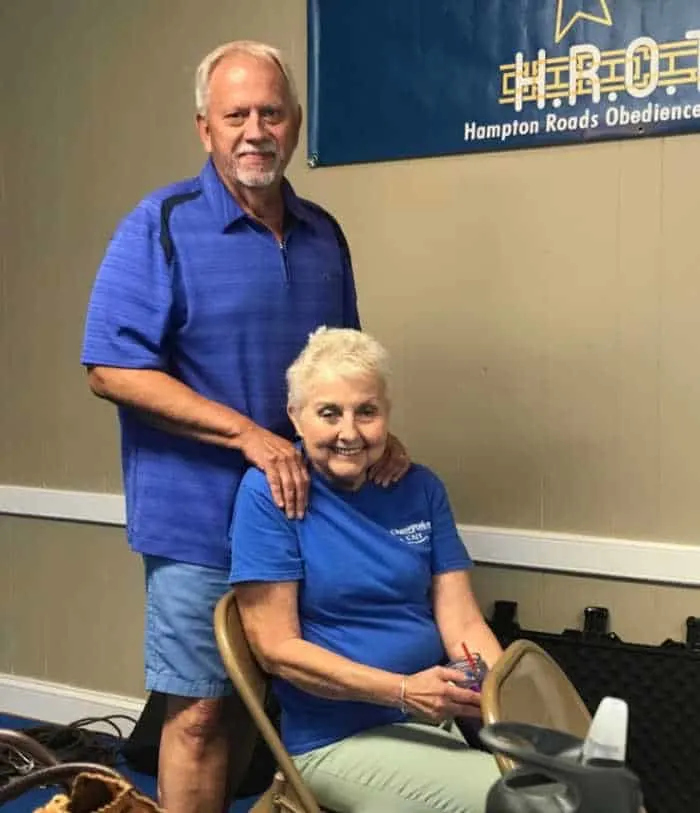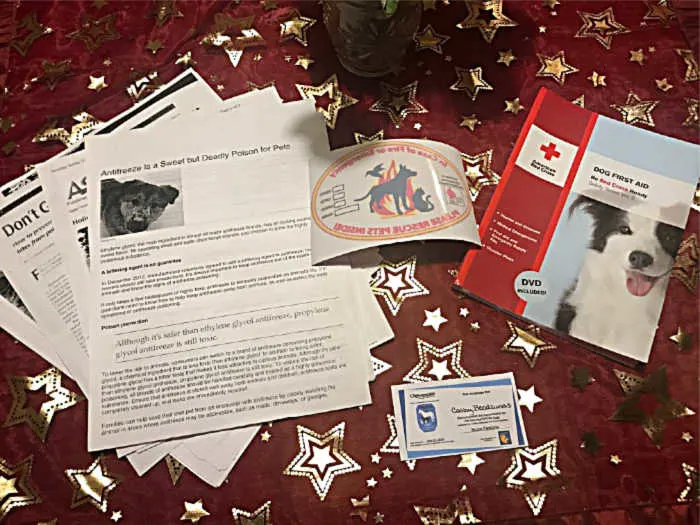I did something last weekend that I would recommend every pet parent do. Can you guess what it was?

I took a class in Canine CPR and First Aid.
I actually took one before many years ago when I was training to be a pet groomer (it was required before I could get my degree).
I actually had to use it once and you can read about that harrowing experience here.
That first class was many years ago and I knew I needed a refresher. If you have pets, you never know when you may need this skill and it could mean the difference between life and death.
So what was the dog first aid course like?
The course was very reasonably priced and lasted 4 hours from 10:30 am to 2:30 pm on a Saturday. There was a video with information on what to do when your dog gets hurt or sick.
The instructors went into more detail after each section of the video and showed us physically how to do different things such as finding a pulse, using the Heimlich maneuver, and how to do CPR and mouth to mouth resuscitation.
They had several dog dummies to practice on and we also had stuffed animals at our table to work on too.
Towards the end, we each got a card with a scenario on it. Mine was that my dog got stabbed by a stick that was stuck in his shoulder. What do I do?
Then I took my stuffed toy dog and got some medical supplies at the supply table and went to work. I wish I had gotten a photo of my completed dog but I was so wrapped up in my work, I just didn’t think of it at the time.
After we were done, we each had to stand up, read our scenario and explain to the class what we did. I got mine right. Yay!

So, a little test for you. What would you do if you found your dog with a stick stuck in their shoulder?
Here’s what I did: I put gauze around the edges where the stick was protruding to hopefully stop the blood.
I used some wire cutters to trim the stick but I didn’t remove the stick. Removing the stick could cause the dog to bleed out.
Then I used some of that self sticking long bandage wraps to wrap the gauze, avoiding the stick as I didn’t want to push it in further.
Then it was time to rush the dog to the vet. If I had someone with me, they could hold the dog.
But if I were alone, I would grab a board (a large plastic lid to those big plastic storage boxes works great for this) and lay the dog sideways on the board, wound side up.
I would use some more of those long bandage wraps to secure him to the board. You don’t want him moving around where he can accidentally push the stick in further and do more damage.
Then I would get him to the vet as fast as I could.
Oh also, I would muzzle him before working on him. Even though your dog loves you dearly, when he is in horrible pain, he may bite you.
Here is Louis and Suzie who ran the course. They were sweethearts and very knowledgeable.

I also got some tips on things to add to my pet first aid kit.
- A man’s neck tie to use as a makeshift muzzle. If your dog is conscious and in pain, you always want to muzzle them first to avoid being bitten. Of course you can buy a muzzle too but a tie will work with any size dog.
- An old plastic card (credit card, hotel key card, used gift card, etc.) If your dog gets stung by a bee or wasp, use the card to scrape the stinger out of the skin. If you use your fingers or tweezers to remove the stinger, you could inadvertently squeeze more venom into your dog.
- Some makeshift funnels. This idea is genius! If you are squeamish about putting your mouth over your dog’s when giving mouth-to-mouth, keep these on hand to put over the dog’s nose and mouth:

These are funnels made from different sized plastic drink bottles (for different sized dogs). The edges are covered with duct tape so as not to be sharp. Then you just place the larger opening over the dog’s mouth and nose and breathe into the small mouth hole.
Even if you aren’t squeamish, these funnels work well for a cat or a flat nose breed such as a French bulldog or a pug.
At the end of the class, I left with my certification card, a bunch of dog health handouts, a first aid book and a sticker to put on my door telling fireman how many pets I have.

How to Find a Pet CPR and First Aid Class
I found mine through a local dog training club.
If you want to take a class in your area, check with your local SPCA and see if they are hosting any classes.
Or just google pet first aid class and the name of your city and see if something comes up.
Your vet may also know of some classes in your area.
If you absolutely can’t find a class where you live, you can take an online class through the American Red Cross here.
That’s a last resort though because I really think you benefit more by actually practicing these skills in a group setting with instructors right there.
So have you ever taken a pet first aid course? I’d love to hear about your experience.

